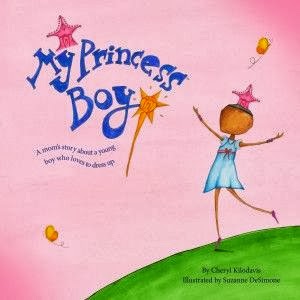For those who have not had the opportunity to read this piece of literature, I highly recommend doing so. It is a very well-written and informative article. To briefly summarize this reading, the author explains his situation regarding his son who wears dresses, heals, and make-up. This is a piece of his life Matt keeps secret to his co-workers and only shares with his close friends. The reason behind this is because Matt is a stereotypical “guy’s guy” and does not wish for others around him to treat his son differently because he appears to deviate from the so-called norm. Matt supports every decision his son makes regardless of whether or not it’s a “masculine” or “feminine” one.
Within this post, Matt makes a valid point in terms of his son’s “differences.” Matt explains that what his son wears and what toys he plays with is irrelevant because his son is happy and evidently that is the only thing that matters.
During class last week, our professor introduced the children’s story “My Princess Boy” written by Cheryl Kilodavis. This story articulated similar issues that both parents were facing when raising their “gender creative” sons.
I said this in an earlier post, and I am going to mention it again. The overall bottom line when it comes to children is whether or not they are happy, safe, and healthy. Nothing else should be a concern to other children, teachers, parents, or any other set of individuals who feel gender stereotypes need to be followed on a strict basis. Who said gender norms were normal anyways? What does normal even mean?
In the book, Cheryl explains that raising a boy that prefers to wear girls’ clothing isn’t wrong, and that we should be accepting of them instead of trying to change them. With that being said, it’s difficult to ignore the outside pressures that come from the remainder of society. It is clear that Mike and Cheryl are not the only individuals who are dealing with a son that likes the colour pink. Many parents around the world seemed to find Cheryl’s book to be a helpful tool when accommodating their effeminate son(s).
The class discussion that derived from reading this storybook hit very close to home. My little cousin, Owen, is a Princess Boy. In fact, my aunt recently bought this book just for him. It’s difficult to understand what it means to be around a boy who wants to be like a girl unless you personally know one. It's easy to pass judgments on someone you've only casted eyes on but never spoke to before.
To explain further, Owen is your typical six-year old child who lives at home with his mom and dad. The only difference between Owen and other youths his age is that his favourite colour is pink; he loves sparkles; and would rather play with Barbie and Bratz dolls than trucks. Is there anything wrong with Owen? Absolutely not! Is he happy? Yes!
It doesn’t matter if this is just a phase or how Owen will be for the rest of his life, but what breaks my heart is how he will unfortunately be treated when he finishes grade 1. For now, other children aren’t overly concerned with his outfits or choice of friends (girls), but soon enough they will be. I’m worried about Owen’s safety when he gets older, and more importantly I’m worried about his feelings. Kids are cruel these days and I can only imagine the mistreatment and discrimination he will be subjected to in a short time.
It doesn’t matter if this is just a phase or how Owen will be for the rest of his life, but what breaks my heart is how he will unfortunately be treated when he finishes grade 1. For now, other children aren’t overly concerned with his outfits or choice of friends (girls), but soon enough they will be. I’m worried about Owen’s safety when he gets older, and more importantly I’m worried about his feelings. Kids are cruel these days and I can only imagine the mistreatment and discrimination he will be subjected to in a short time.

No comments:
Post a Comment